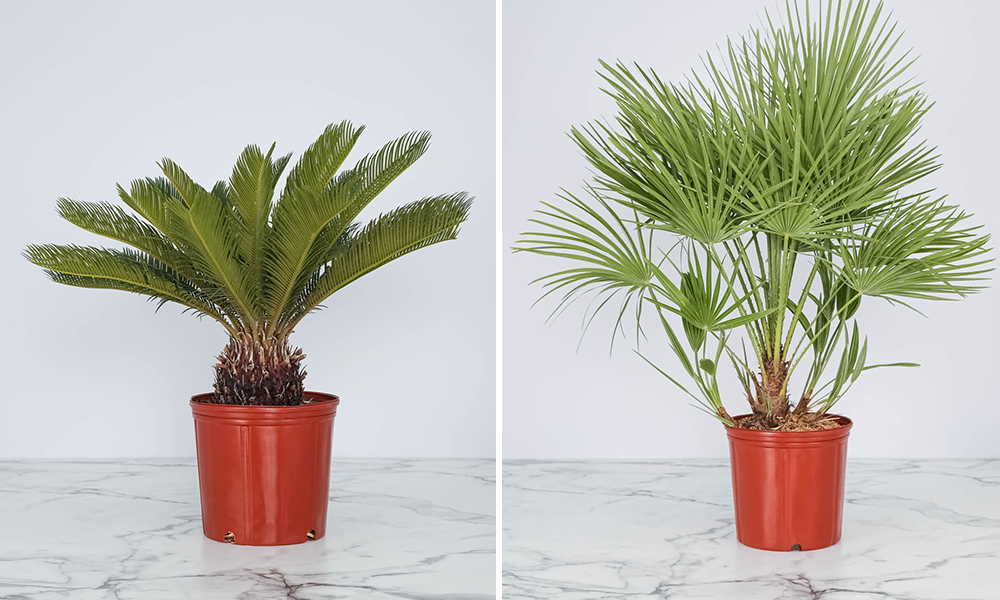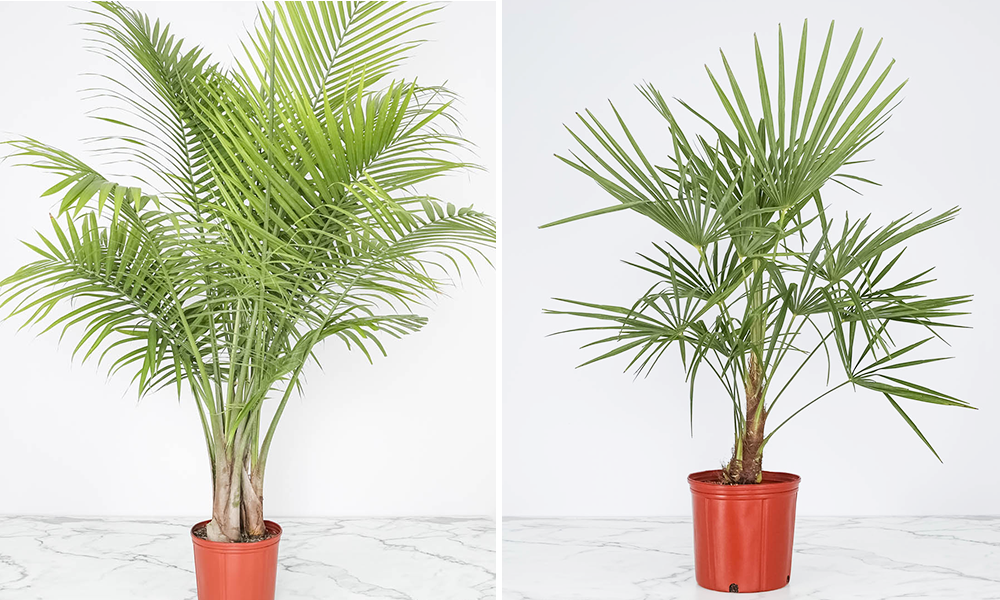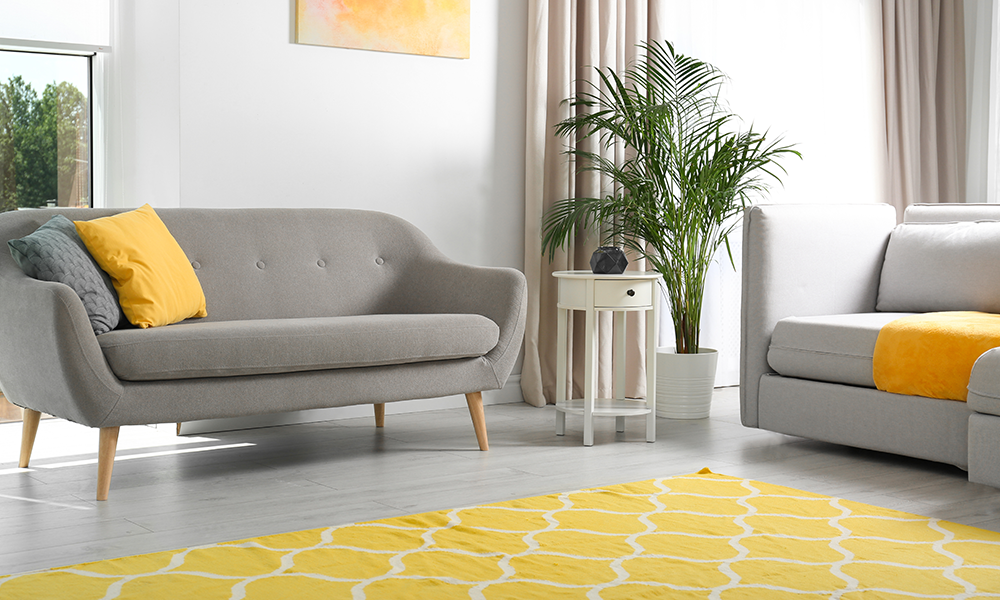As the icon of exotic getaways, palm trees are about as tropical as a plant can get. For our readers in the South, they’re an easy, native addition to your landscape that you can bring inside to add a beachy vibe to any room. To our northern readers convinced that palms just won’t survive in their climate—don’t stop reading quite yet! Everyone deserves to enjoy the lush beauty of palm trees, and if they can’t decorate your garden, then they can sure as heck decorate your home!
Our Favorite Palms
If you’re looking for an exotic accent to your home, patio, or garden, look no further than our favorite palm trees—all of which are available in 3-gallon pots through our online store.
Windmill Palm: These trees display a compact crown of large, fan-shaped leaves that sit atop a 10-12 foot trunk, giving the tree a windmill-like appearance. They’re pretty tough as palm trees go, hardy to USDA zone 5-10 and capable of surviving temperatures as low as -10 ̊F. They can grow in full sun to shade, and they require an average amount of water. Due to their hardiness and relatively small size, they work great as both indoor and outdoor accents.
Sago Palm: A Japanese native, this small tree is known for its stiff, feathery fronds that remain more upright than other varieties. They’re not true palms, but they do have their exotic appearance combined with the hardiness of a cycad—one of the oldest known groups of plants. Sago’s small size (they only grow to about 3-4 feet tall) and low water requirements make it a great houseplant. Outside, it can still thrive in partial to full sun in USDA zones 7-10.

Roebelenii Palm: Roebellenii is a multi-trunked (normally three trunks) tree, topped with a dense canopy of glossy green fronds. In the spring, they produce cream-colored flowers that turn into small, black fruits in the fall. Their ornamental appeal, combined with their gracefully arching branches, make them an elegant addition to your home or patio. They enjoy partial to full sun and require an average amount of water.
Majesty Palm: Although they can reach heights of up to 15 feet when planted outdoors, these slow-growers also come in sizes appropriate for decorating your home. They’re known for their characteristic gray trunk and delicate, pinnate leaves that have a slight upward arch. They enjoy the bright sun but can also grow in the shade, and they can survive temperatures as low as 32 ̊F.
European Fan Palm: This variety’s attractive, fan-like blue-green leaves and hardiness to cold (as low as 10 ̊F!) make it one of the most popular choices for homes and gardens alike. It grows only to about 10-15 feet in the yard, making it an excellent choice for people who don’t have much room. They enjoy partial to full sun and have pretty low moisture requirements.
Chinese Fan Palm: This variety can grow up to 25 feet tall, so you sure can’t miss their deeply lobed, fan-shaped leaves. Unlike its European cousin, this variety has the thirst of a true tropical, so you’ll have to make sure it’s watered often and planted only in partial sun. Despite their tropical nature, they’re hardy up to 27 ̊F.

Caring for Potted Palm Trees
If you’re into that urban jungle aesthetic, look no further than indoor palm trees. Their pinnate leaves and vivid green color give your home a lush look that no other plant can achieve. Although they’re pretty adaptable, your plant will last much longer if it’s cared for properly. Remember that each plant has its own set of preferred conditions, so it’s always a good idea to check what they are when you purchase a new plant. In saying that, we do have some basic tips for potted palm tree care that might guide you in the right direction.
The most important thing about planting palms is to remember that most of them aren’t particularly fond of wet soils. It’s much better to use a loose, porous soil mix, like cactus soil mixes, rather than heavy, moisture-retaining soils. When in doubt, under-watering will cause less damage than over-watering. Water only when the soil feels dry to touch, and choose containers that allow water to flow freely through the drainage holes at the bottom.
Although these plants certainly need natural light to keep their foliage fresh and green, they can actually adapt to pretty low light conditions. This makes them perfect for adding a little bit of life to the dull corners of your home. Although they can grow with minimal light, most of them prefer bright but indirect light. Some can even thrive in full sun, although many palms will scorch in direct sun.
If you’re wondering how to repot plants in the palm family, you should know that it’s best to leave them undisturbed in their potted home until absolutely necessary. For indoor plants, you might even want to keep them rootbound for a little longer to stunt their growth, so they don’t outgrow the room quite as quickly.

How to Care for Outdoor Palms
There’s a reason these trees are only native to the South—they struggle in cold temperatures and don’t fare well with frost. Luckily, there are a few hardy varieties that can extend the tree-growing line a little further north, like the windmill palm and fan palms. These guys will give you a feeling of warmth all year long, even when they’re dusted with snow! For the best results, check your local growing zone to make sure you’re picking plants that are suitable for your region.
Just like indoor or potted palms, make sure the site you choose is right for the variety you’re planting. Most varieties will appreciate well-drained soils that are rich in organic nutrients. Some trees can grow pretty tall and develop surprisingly wide canopies, so make sure you space them apart correctly—as a rule of thumb, you’re usually safe spacing them as far apart as their mature height. You can plant them a little closer together if you know their canopy won’t be as wide as they are tall.
During the first few months, while your plant is still getting established, water it frequently to keep the soil consistently moist (but not wet). The first spring after planting, make sure you give your young plant a boost with a low-phosphorus, granular fertilizer (3-1-3), and repeat in the summer and fall. After that, one feeding each spring is sufficient.
The best thing about cold-hardy palms is that they don’t require much care once they’re established. Like the rest of your trees, remember to include your palms in your pre-winter garden prep to ensure they’re well-protected for the coldest months of the year. Keep watering them throughout the fall so that they have plenty of moisture, even when the ground freezes. Mulching the base of the plant will help with retaining moisture and regulating the temperature, keeping their roots a little cozier for the cold season.
You can remove dead fronds as necessary, but keep in mind that they might still be supplying your tree with nutrients even after they’ve turned yellow. Only remove completely brown fronds, and never remove so much that you’re leaving your tree with just a few lonely leaves.
Whether they’re standing in your garden, decorating your patio, or providing a bright accent to a dull space in your home, palms add vivacious energy wherever they are. Don’t hesitate to add one to your plant collection today!


Very nice tips about palm tree. Palm plants are robust and versatile, which is why they are adored across the world as epic houseplants!
Great tips! I really loved reading this blog! Very useful and eye-opening tips. Thanks for writing this down and sharing it! I am gonna write these tips down and use them when the time comes. Thanks!